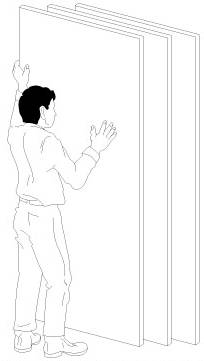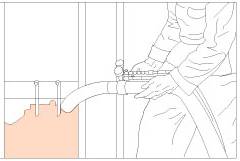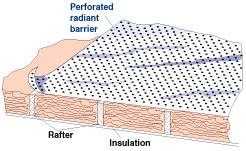Safety - When installing insulation it is important to wear adequate safety products, including, glasses, goggles, dust mask, respirator, work gloves and coveralls.

Figure 1 - Rigid foam insulation
- Rigid Foam:
- Spray-on Insulation:
Rigid foam insulation (Figure 1) is made from several different types of plastic foam, each with a different R-value. The most common application for rigid foam is as an exterior insulation wall sheathing. Some rigid foam insulation has the significant advantage of being resistant to water, and so is the best insulation for below grade foundation insulation.
Extruded Polystyrene Insulation
Each manufacturer of extruded polystyrene insulation colors there product differently - white, blue, green, yellow and pink. For the homeowner there is no discernible differences between the products. Extruded polystyrene insulation is an excellent choice for below grade foundation insulation as it is basically impervious to water. The typical R-Value of the material is 5.0/inch.
Expanded Bead Polystyrene
The street name for expanded bead polystyrene is beadboard
. The material is produced by fusing small nodules of polystyrene together, trapping air pockets between the nodules. Typical R-Values are between 3.5 and 4.5/inch of material. It is a good choice for below grade applications.
Polyisocyanurate
Not generally recommended for below grade applications polyisocyanurate is generally manufactured with a foil vapor barrier applied to one or both sides. The industry recognizes this product as iso board
. It has the highest R-Value per inch - 7.2 to 8.7.
Note 1: Most if not all rigid foam insulation is flammable. Most building codes require that the product be covered with a fire-rated material if it is used in living spaces or basements. Some building codes even require a fire-rated covering if the rigid foam is used in a crawlspace. It is important to check with your local building department to ensure that you are following installation guidelines. Failure to do so, could void your homeowner's fire insurance.
Note 2: Many rigid foam insulation products are NOT environmentally friendly as they use CFCs in their production. If you are concerned about environmental damage you should check with the specific manufacturer of the rigid foam you are planning on purchasing to determine if in fact they use CFCs in their production.
Several types of insulation can be applied as liquid or wet slurry, see Figure 2. These spray-applied
insulation materials are used mostly in new construction of walls, but some contractors use them in attics for both new and retrofit construction.
Urethane
Sprayed on urethane insulation provides 2 benefits. It has a very high R-Value (6.0/inch) and it prevents the majority of air leaks in the area being insulated. The negative is that it is manufactured using CFCs. A common application is in attics where a thin coating is applied on the attic floor prior to installing batt, blanket or loose fill insulation. The urethane will seal the attic from any air ingress from the living quarters.

Figure 3 - Blow-in-blanket
(BIB) insulation system
- Reflective Insulation:
Blow-In-Blanket
A unique method for installing either loose-fill or cellulose in walls is called the Blow-in-blanket
or BIB
system.
Providing an R-Value of 3.9/inch, the Blow-In-Blanket insulation technique is similar to the wet spray cellulose with the exception that the insulation is contained by a nylon scrim which has been fixed to the studs. This method creates a light weight blanket of insulation and can be used with either fiberglass or cellulose loose fill insulation.
Cellulose - Wet Spray
By mixing water and a chemical adhesive with loose fill cellulose spray, the material, when blown into cavities between wall studs, floor and ceiling joists sticks to the surfaces and creates a blanket of insulation. Wet cellulose is usually used in new construction. This technique, less the adhesive, can be used to reduce dust levels when blowing cellulose insulation into attics.
Cellulose - Wet Spray
By mixing water and a chemical adhesive with loose fill cellulose spray, the material, when blown into cavities between wall studs, floor and ceiling joists sticks to the surfaces and creates a blanket of insulation. Wet cellulose is usually used in new construction. This technique, less the adhesive, can be used to reduce dust levels when blowing cellulose insulation into attics.

Figure 4 - Reflective insulation
Reflective insulation works completely differently from all the other types of insulation previously described. When installed over attic insulation, reflective foil or metalized plastic products reflect heat away from the attic floor in summer. Referred to as radiant barriers
, these products will save up to an additional 8% on your cooling bill if installed over R-19 attic insulation.
The most common use of reflective insulation is in industrial and commercial applications. The structure of the foil reflects heat away from the area below. The product itself, has very little actual insulation qualities.
